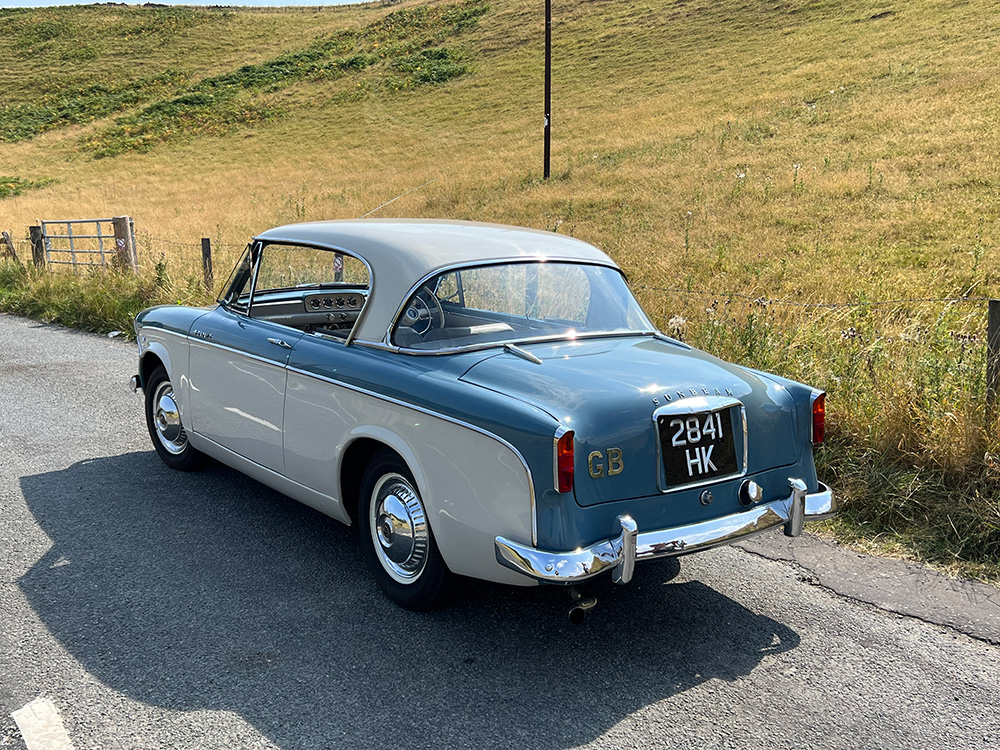Car of the Week
Sunbeam Rapier 1957
Owner: Malcolm Oswald - Edinburgh
The Sunbeam Rapier is an automobile produced by Rootes Group from 1955 until 1976, in two different body-styles - the "Series" cars (which underwent several revisions) and the later (1967–76) fastback shape, part of the “Arrow” range.
The first generation Rapier was the first of the “Audax” range of light cars produced by Rootes, in this instance as part of their Sunbeam marque. Announced at the London Motor Show in October 1955, it preceded its Hillman Minx and Singer Gazelle counterparts which were not introduced until 1956. A four-seat, two-door hardtop coupe’ (designated Series I, with the introduction of the Series II in 1958) it was different from the Sunbeam Mark III, the car it would eventually replace.
Although designed "in house" by the Rootes Group, it was inspired, via the Raymond Loewy design organisation, by the new-generation Studebaker coupes of 1953. The styling of the Series I Rapier was undertaken by the design firm of Raymond Loewy Associates and showed a great deal of influence of his 1953 Studebaker Starliner and subsequent Hawk, (itself an acclaimed design).
Announced in October 1955 for the Motor Show and available in a range of two-tone colour schemes typical of the period, it had a steering column gear change, leather trim and a Laycock de Normanville overdrive as standard fittings. Vinyl trim was an option in the UK and standard in certain export territories. Rapier bodies were built by Pressed Steel, shipped to Thrupp &Maberly in north London where they were painted and trimmed, then shipped again to the Rootes assembly plant near Coventry where the engines, transmission and running gear were fitted. This complex situation persisted until late 1963 when the Series IV was introduced.
The Rapier's 1,390 cc (85 cu in) engine was essentially the same as that fitted to the Hillman Minx but with a raised compression ratio (8:1 instead of 7:1), a Zenith DIF 36 carburettor and revised inlet and exhaust manifolds. In this form it developed 62.5 bhp (47 kW) at 5000 rpm. A column change, 4-speed transmission with overdrive on third and top was included in the price as a standard feature.[1]
From October 1956, directly as a result of experience gained in international rallying by Rootes' competition department, the Rapier was fitted with the updated R67 engine on which the Stromberg carburettor was replaced by twin Zenith 36 WIP carburettors on a new inlet manifold. This engine produced 67.5 bhp (50 kW) at 5000 rpm, the effect of which was to reduce the Rapier's 0-60 mph time by almost 1 second and increase its top speed by 3 mph.
British magazine “The Motor” tested a Series I twin carburettor saloon in 1957, recording a top speed of 85.7 mph and acceleration from 0–60 mph in 20.9 seconds and a fuel consumption of 30.5 miles per imperial gallon. The test car cost £1,043 including taxes of £348. In competition, a Rapier driven by Peter Harper finished in fifth place in the 1958 Monte Carlo Rally. In total, 7,477 units were produced of this initial version of the Sunbeam Rapier. It was discontinued in 1958 on the introduction of the Series II.
Malcolm has been captivated by the shape and colours of the Series 1 Rapier ever since his father owned one from 1956-1963 when he was young. He purchased the present car in 1981 from the second owner, an old man, who lived in Colchester. It was in good original condition with around 44,000 miles on the clock. Malcolm was by then involved in the Motor Trade and decided to make it as perfect as possible, bodily, and have it resprayed in the original colours of his father's Rapier, Summer Blue and Pearl Grey. The car has remained in that condition ever since with no welding underneath and still carrying the same exhaust Malcolm made up for it in 1984. The cylinder head has never been removed and it has all original ancillaries with a mileage now showing around 51000. To Malcolm’s regret he sold it in 1989, to a man who also lavished much care on it, on condition that he had first refusal if it was to be re-sold. He then re-purchased it in 1996 and vowed never to sell it again. The car has always been garaged, has done only a small mileage since 1981 and has won many awards.
General information Source: Wikipedia
1. Wikipedia: Autocar 196701



Submit your entry for Car of the Week - share your restoration story and the back history of your special vehicle.
Email: pcct@perthrotary.co.uk
Our charities

Prostate Scotland
- A Scottish charity set up to provide information, advice and help on prostate health and diseases test and treatments. Nearly 1 in 2 men in Scotland will be affected by prostate disease at some stage of their lives and 1 in 10 are likely to develop prostate cancer.

Race Against Dementia
- Race Against Dementia identifies, funds and guides pioneering scientists from across the world. We work to achieve better diagnoses, understand risks, develop treatments and find a cure for dementia. We support groundbreaking research to find a cure – faster.